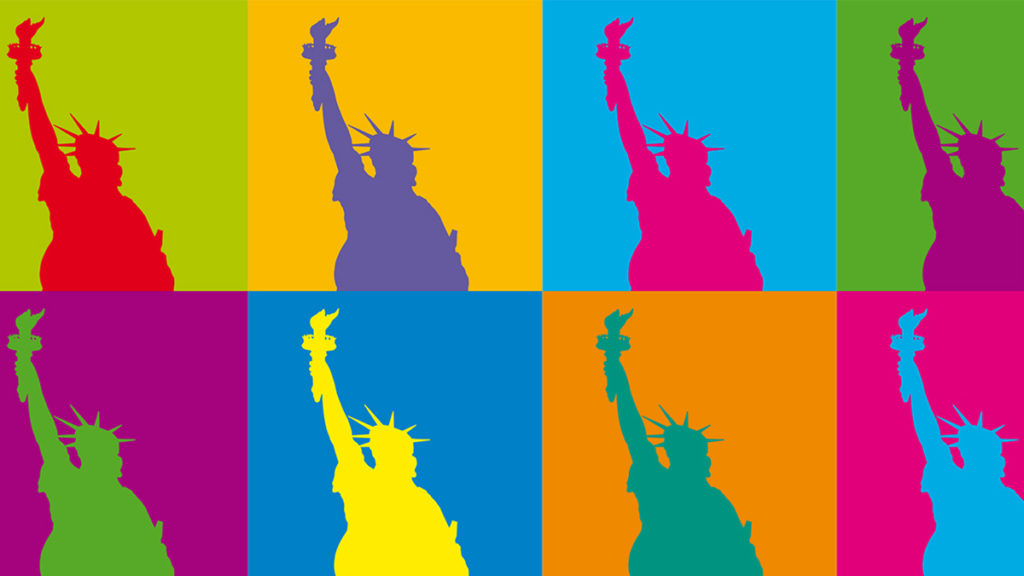Looking back over the second half of the 20th century, among the observations one can make about American society is that our artistic and entertainment assumptions were increasingly dominated by pop culture as the decades passed. From the grand division of culture into high and low that solidified toward the end of the 1800s, the winner one hundred years later seems unquestionably to have been pop.
Pop culture as we know it began with the age of industrialization, which for America means the years after the Civil War. Two driving forces allowed popular culture to flourish: one from the supply side and the other from the demand side, both of which were made possible by the free and unregulated society of 19th-century America.
On the supply side, making possible the constant influx of new entertainment that constitutes pop culture were Industrial Age advances in communication and mass production. The sudden ubiquity of dime novels, Horatio Alger stories, nickelodeon parlors (early movie theaters), and professional baseball all depended on new means of technology and communication and the free market in which they emerged.
In terms of demand, these same years also saw the first massive immigration to the United States from Eastern and Southern Europe. Most immigrants then spoke a language other than English and brought cultural traditions and customs that set them apart from the bulk of those who were already here. How to transform this increasingly diverse population into a unified American people was not in the least bit clear.
Folklore fades; pop culture pervades
The natural currents of pop culture form instant communities where none exist.”]
The freedom of individuals to associate helped bring about a solution. Far more readily than by centrally directed planning, the natural currents of pop culture form instant communities where none exist. Back in the Gilded Age of the late 19th century,pop culture did this most readily among the children and grandchildren of immigrants.
They may have had little in common with each other, but they shared an ability to laugh at the silent shorts of the nickelodeon and follow the exploits of the first generation of professional baseball players engaging in a game they themselves could play in the crowded streets and empty lots of New York City, Pittsburgh, and St. Louis.
As these children (if not their parents) embraced English, they could bond over exciting stories of gunslingers out west. From its beginning, pop culture has always been the interest of the young and has depended to a high degree a free and open society for its existence.
Before our polyglot world of mass movement and mass immigration, what we know as pop culture didn’t exist. The job it serves now was handled by what we call folklore.
In homogenous cultural communities, the authority of folklore gives a community the commonalities that form its anchors. It was only with the rise of heterogeneous cultural communities that a common folklore ceased to be able to fulfill its traditional mission and pop culture arose to take its place. The difference between folklore and pop culture, however, rests in the former having an authority in tradition and the other having an appeal rooted in novelty.Pop culture vs. traditional culture
Despite its constructive role of fusing disparate groups of people together, pop culture also grew to play an antagonistic role, particularly toward traditional culture. Authors like Shakespeare, Bunyan, and Swift; composers like Bach and Handel; and painters like Rembrandt and Gainsborough were unquestionably popular and new at one time, but their works evolved over the years into a canon less easily accessible.
Pop culture, by contrast, is quickly and easily absorbed. In April 1969, American art critic Clement Greenberg criticized pop art for being “too agreeable, too readily pleasing; it doesn’t challenge your taste enough. That’s why it became so popular so quickly.” Such an observation is valid with all pop culture, not just the paintings of artists such as Andy Warhol and Roy Lichtenstein.
The best art, Greenberg further elaborated, “makes you a little more uncomfortable at first, challenges you more. It doesn’t come that far to meet your taste or meet the established tastes of the market.” Marketability, however, is and always has been a key ingredient in popular culture.
There’s a complexity here to which lovers of liberty and defenders of tradition have to attend. The problem comes when good elements like liberty and freedom work in a way, abetted by mass marketing, that results in the dismissal of challenging cultural expressions long regarded as essential to those who seek to understand the human condition.Pop culture and the tyranny of presentism
While its specifics may grate on the ears and eyes of parents — and it’s in part designed to do just that — pop culture itself isn’t bad. What is truly detrimental is a growing relativism that denies a difference between pop culture and other more canonical cultural expressions, as well as the loss of the ability to differentiate between levels of significance.
The greatest risk is to surrender to the tyranny of presentism.”]
The greatest risk , increasingly valuing novelty over permanence and making a culture in which there is little expectation of, or regard for, a broad and widely held knowledge of the past.
A cultural egalitarianism fueled by mass marketing and championed by an ill-informed audience that sees its validity only in its numbers is as much a threat to tradition as any centralized government jealous of a rival locus of authority. As intellectual historian and political scholar Richard Weaver once put it, “A simple expression of majority will is not always a good thing, is not always a final verdict on matters. For that reason, [the conservative] tends to set a great store by traditional usages, and also by formulations such as constitutions, which represent settled opinions and, in a sense, directives.”
The willingness to accept a little difficulty in understanding a work of art is anathema to pop culture but central to all other kinds of culture. Abandoning that willingness would not only reinforce our tendency to downplay the role of history in what constitutes an education, it would make us increasingly disdainful of the curiosity that might lead to experiencing anything more than what’s popular — and most aggressively marketed — today.



